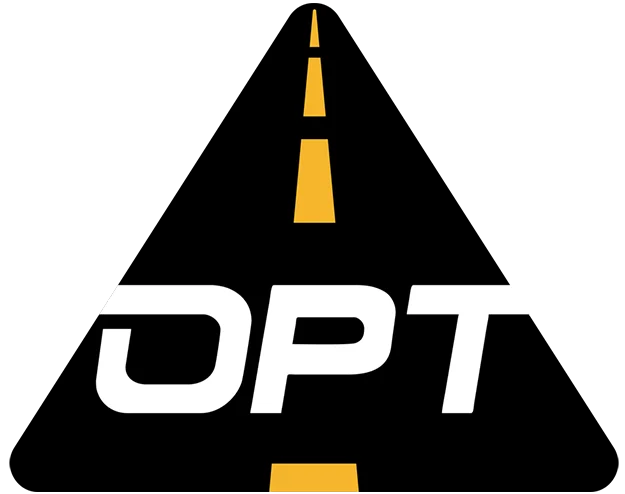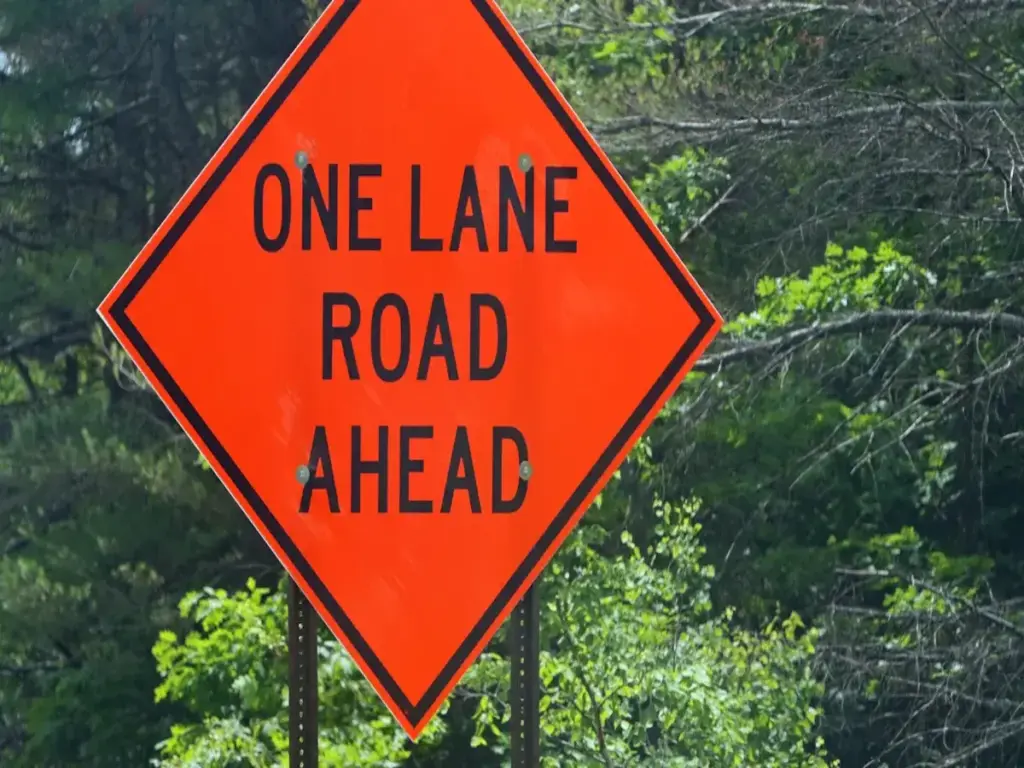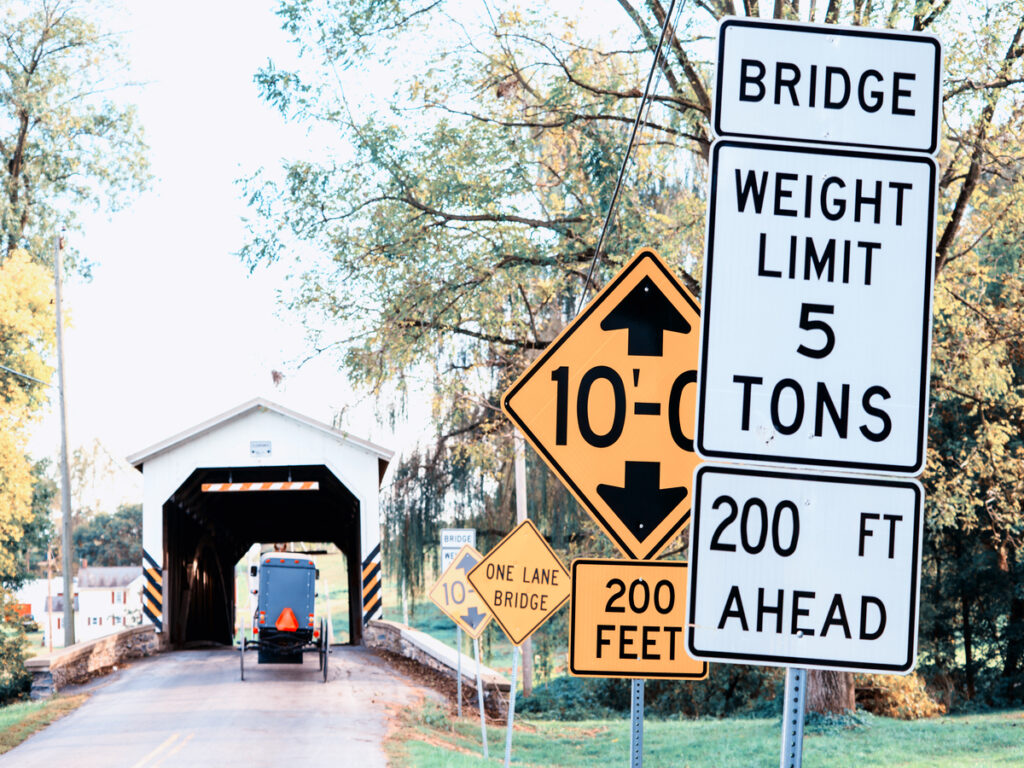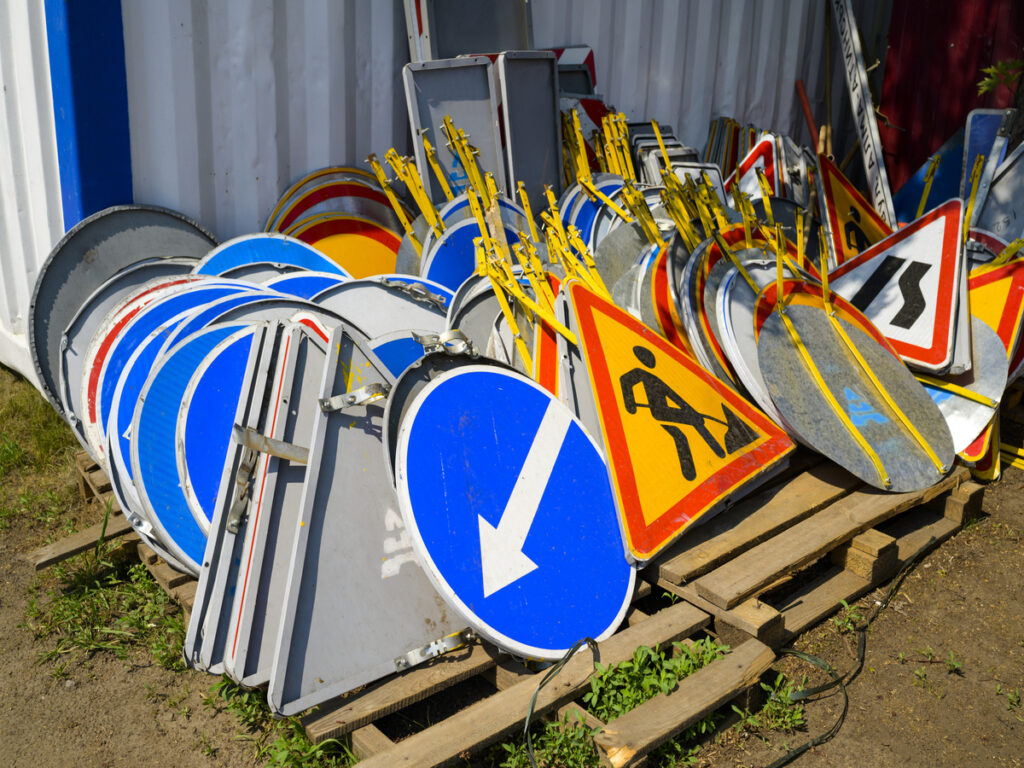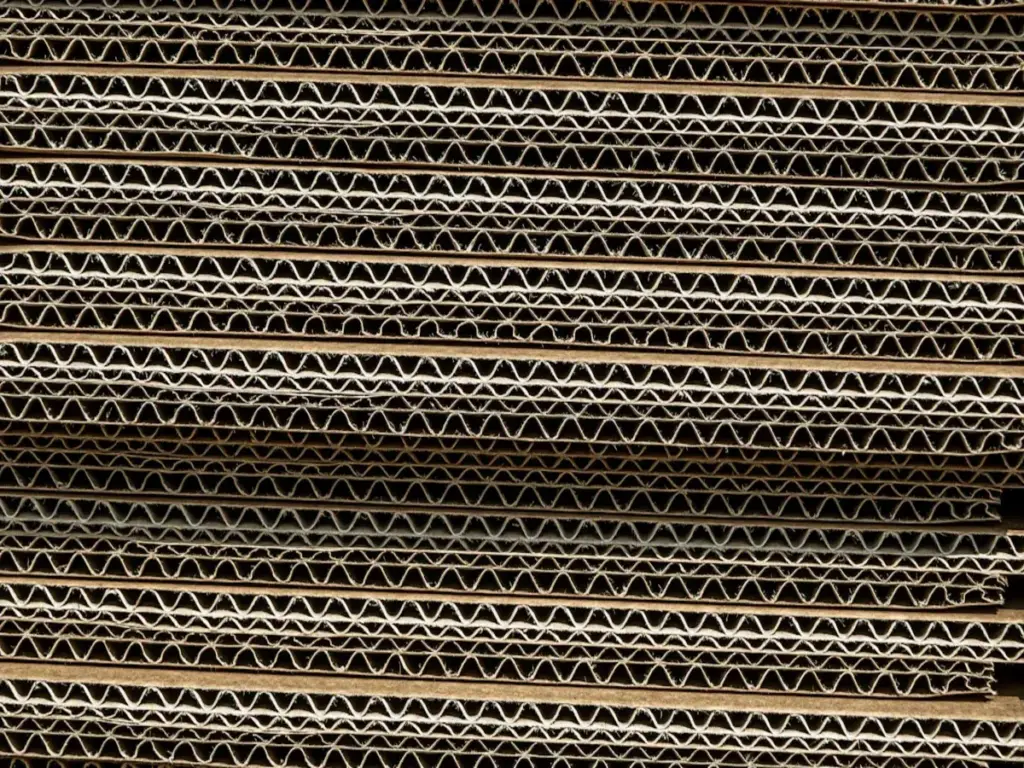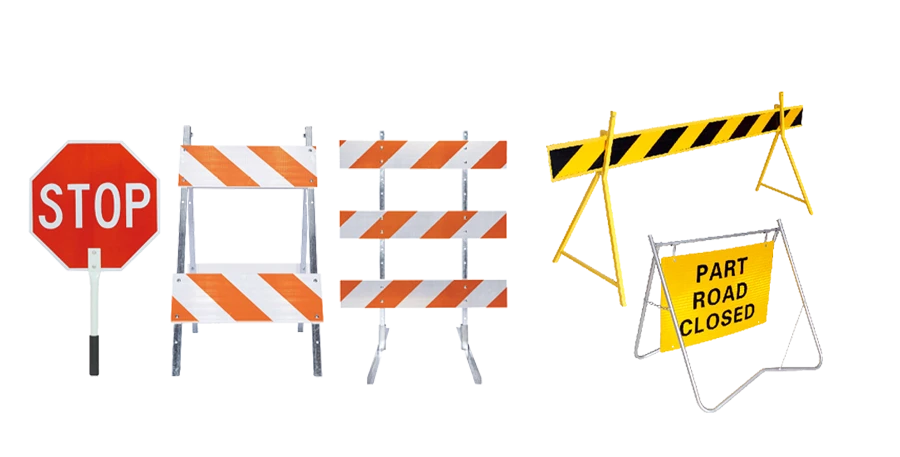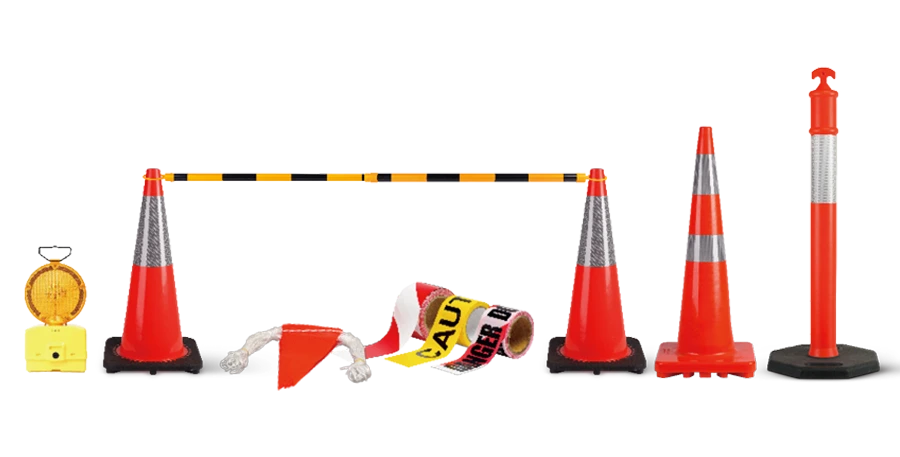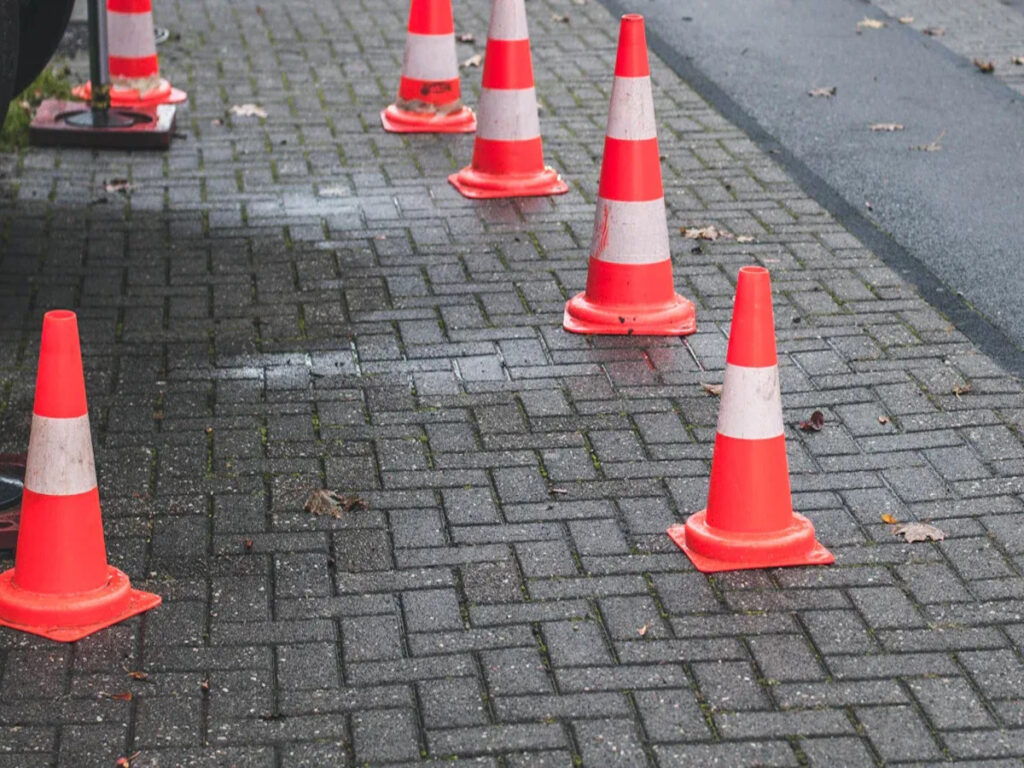
El espaciado adecuado de los conos de tráfico desempeña un papel vital para mantener seguros a los conductores y trabajadores en las zonas de control de tráfico.. Las distancias recomendadas dependen de los límites de velocidad.. Por ejemplo, en 40 mph, la separación máxima entre conos es 20 pies en conos y 40 pies en tangentes. En 45 mph, el espaciamiento aumenta a 30 pies y 60 pies. Carreteras con velocidades de 50 mph o más requieren distancias aún mayores.
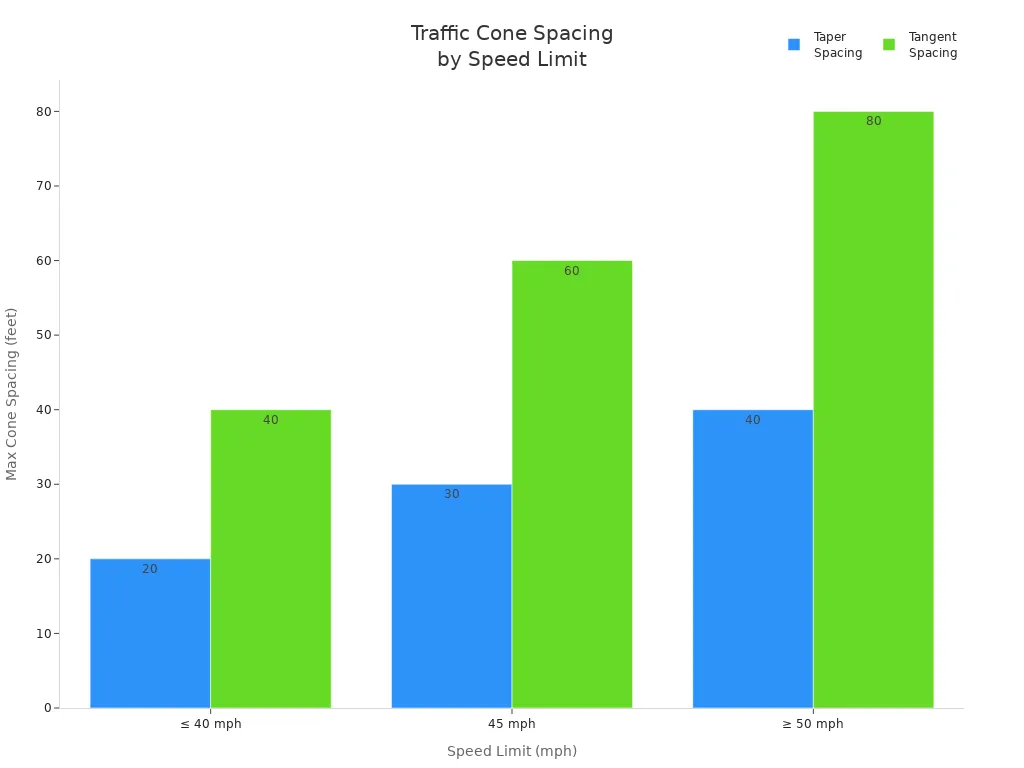
| Velocidad (mph) | Espaciado máximo de conos (Afilar) en pies | Espaciado máximo de conos (Tangente) en pies |
|---|---|---|
| ≤ 40 | 20 | 40 |
| 45 | 30 | 60 |
| ≥ 50 | 40 | 80 |
El espaciado correcto de los conos para el control del tráfico ayuda a prevenir accidentes y mantiene los vehículos en movimiento sin problemas..
En OPTRAFICO, Ofrecemos de alta calidad conos de trafico y otros productos de control de tráfico diseñado para mejorar la seguridad y la eficiencia en la carretera. Ya sea que esté administrando un sitio de construcción o estableciendo un desvío temporal, Nuestros conos y barricadas brindan la visibilidad y durabilidad que necesita para mantener el tráfico en movimiento de manera segura.. Explorar nuestra gama de soluciones de control de tráfico hoy!
Control de llave
- La separación correcta entre los conos de tráfico es muy importante para la seguridad. Utiliza las distancias adecuadas para cada límite de velocidad para evitar accidentes.
- Una buena ubicación del cono brinda a los conductores suficiente tiempo para ver y reaccionar.. Esto les ayuda a mantenerse seguros cuando la carretera cambia..
- El espaciado correcto mantiene el tráfico en movimiento sin problemas. Detiene la confusión y reduce los retrasos en las zonas de trabajo..
- Piensa siempre en la carretera y el clima cuando coloques los conos.. Cambie el espacio si necesita mejor visibilidad o seguridad..
- Revise y mueva los conos con frecuencia. Esto garantiza que el control del tráfico sea seguro y funcione bien para conductores y trabajadores..
Beneficios de seguridad del espaciado adecuado entre los conos de tráfico
Prevención de accidentes
Los conos de tráfico ayudan a evitar accidentes en las zonas de trabajo. Cuando los trabajadores colocan los conos a la distancia adecuada, Los conductores ven a dónde ir.. Esto les ayuda a no apresurarse., movimientos inseguros. Los estudios demuestran que usar el espacio correcto entre los conos significa menos accidentes. La siguiente tabla muestra cómo el espacio entre los conos cambia con la velocidad.:
| Límite de velocidad (mph) | Espaciado de cono (pies) |
|---|---|
| 25 mph | 20–25 pies |
| 40 mph | 40 pie |
| 55 mph | 55 pie |
| 70 mph | 70 pie |
Poner los conos de cara al tráfico los hace más fáciles de ver.. Los trabajadores deben salir al menos 30 pies entre cada cono. Esto les da a los autos un camino claro a seguir. Los conos adicionales pueden mostrar dónde hay peligros o cosas en el camino.. Esto ayuda a los conductores a rodearlos de forma segura.. Esta configuración hace que el camino sea fácil de seguir y mantiene a todos más seguros..
Consejo: Utilice siempre suficientes conos de tráfico para mostrar la zona de trabajo.. Esto ayuda a los conductores a saber dónde conducir y mantiene a las personas seguras..
Tiempo de advertencia adecuado
Un buen espacio entre los conos da tiempo a los conductores para notar los cambios que se avecinan.. Cuando los conductores ven temprano los conos de seguridad vial, pueden reducir la velocidad o cambiar de carril de forma segura. Esto es muy importante cuando los coches van rápido o hay muchos coches..
Una buena línea de conos hace que el camino sea claro y fácil de ver.. Los conductores pueden detectar conos desde lejos y cambiar su forma de conducir.. Esto ayuda a detener paradas o giros repentinos que pueden provocar accidentes.. Usar el espacio correcto entre los conos significa menos accidentes y zonas de trabajo más seguras para todos.
- Los conos de tráfico muestran a los conductores dónde ir.
- Ayudan a frenar accidentes en zonas de trabajo.
- Un buen espacio da a los conductores tiempo para reaccionar ante los peligros..
Beneficios de eficiencia en zonas de control de tráfico
Flujo de tráfico suave
Los conos de tráfico ayudan a los coches a circular con seguridad en las zonas de trabajo. Los trabajadores colocan los conos a la distancia adecuada.. Los conductores saben adónde ir. Esta configuración detiene la confusión. Evita que el tráfico disminuya mucho. Muchos proyectos de carreteras muestran que un buen espaciamiento de los conos ayuda. Hay menos atascos y menos esperas.
- En carreteras, Los conos guían a los automóviles por las obras viales.. Esta configuración evita que el tráfico se atasque. Reduce la posibilidad de accidentes, Incluso por la noche.
- Durante las reparaciones de carreteras, Los trabajadores espacian conos por el límite de velocidad.. Este método ayuda a los conductores a ver los cambios con antelación. Detiene los cambios bruscos de carril.
- El manual de dispositivos de control de tráfico uniformes (Muescato) dice usar un 20:1 tasa de tasa. Esta regla ayuda a que los autos circulen sin problemas por las áreas de trabajo.
Los conos de tráfico despejan el camino para los conductores. Cuando los conductores ven una línea de conos, ellos lo siguen. No se detienen ni hacen giros bruscos. Este proceso ayuda a que los autos sigan moviéndose. Reduce los retrasos. Usar los conos de la manera correcta ayuda a que los vehículos de emergencia pasen más rápido.
Nota: Una buena colocación de los conos puede ayudar a que los automóviles se muevan más rápido en las zonas de trabajo.
Cumplimiento y respuesta del conductor
Los conos de tráfico hacen más que marcar áreas de trabajo. Ayudan a los conductores a seguir las normas en las zonas de tráfico. Cuando los trabajadores espacian los conos correctamente, Los conductores saben qué esperar. Esto ayuda a los conductores a mantener la calma y seguir las señales..
Siguiente Reglas MUTCD para conos muestra a los conductores una ruta segura. Esta configuración ayuda a los conductores a seguir las reglas.. It lowers mistakes. For merging or transition tapers, workers put cones no more than the speed in feet apart. Por ejemplo, en 40 zona de mph, cones should be 40 pies separados. In tangent or buffer areas, spacing can be doubled. Workers should put cones closer in curves or at night.
Traffic cones help drivers react to changes. Cuando los conos están espaciados a la derecha, drivers slow down or change lanes safely. Este proceso ayuda a que los autos sigan moviéndose. It stops sudden stops and keeps everyone safe.
Traffic Cone Spacing Guidelines by Speed
Choosing the right spacing for traffic cones depends on the speed of the road. The faster vehicles move, the more space drivers need to see and react to cones for traffic control. Proper spacing helps drivers stay safe and keeps traffic moving smoothly. The following guidelines explain how to space cones for traffic control in different speed zones.
Low-Speed Roads (≤25 mph)
On roads with a speed limit of 25 mph o menos, Los conductores se mueven lentamente y tienen más tiempo para reaccionar.. Los trabajadores utilizan espacios más reducidos para los conos de tráfico en estas áreas. Esta configuración crea un camino claro y ayuda a los conductores a comprender a dónde ir..
- Los trabajadores colocan conos de tráfico 10 a 15 pies separados.
- Un espaciado más reducido proporciona una mejor orientación y reduce la confusión..
- Este método mantiene el tráfico organizado y reduce el riesgo de accidentes..
- El flujo de tráfico fluido es más fácil de mantener con este espacio.
Una línea de conos para controlar el tráfico a intervalos cortos hace que la zona de trabajo sea fácil de ver. Los conductores pueden seguir el camino sin hacer movimientos bruscos.. Este enfoque funciona bien en zonas escolares., calles residenciales, y estacionamientos.
Consejo: Un menor espaciado de los conos para el control del tráfico en áreas de baja velocidad ayuda a los conductores a sentirse confiados y seguros.
Carreteras de velocidad media (26–45 mph)
Las carreteras de velocidad media necesitan un equilibrio entre visibilidad y orientación. Los vehículos se mueven más rápido, por lo que los conductores necesitan más tiempo para ver y reaccionar ante los conos de tráfico. El Manual en dispositivos de control de tráfico uniformes (Muescato) da reglas claras para estos caminos.
- Para carreteras con velocidades desde 26 a 45 mph, Los trabajadores utilizan un espacio igual a la mitad del límite de velocidad en pies..
- Por ejemplo, en 40 mph, Los conos para el control del tráfico deben ser 20 pies separados.
- Este espacio ayuda a los conductores a ver la zona de trabajo con anticipación y ajustar su velocidad..
La siguiente tabla muestra el espaciado común para carreteras de velocidad media.:
| Límite de velocidad (mph) | Espaciado de cono (pies) |
|---|---|
| 30 | 15 |
| 35 | 17.5 |
| 40 | 20 |
| 45 | 22.5 |
Los trabajadores utilizan conos de control de tráfico para guiar a los vehículos a través de cambios de carril y alrededor de obstáculos.. El espaciado adecuado mantiene el flujo constante y evita paradas repentinas.. Este método también ayuda a controlar la velocidad del vehículo., Hacer que el área sea más segura para todos.
Nota: Seguir las pautas de MUTCD para el espaciado de conos en carreteras de velocidad media mejora la seguridad y la respuesta del conductor..
Carreteras de alta velocidad (46+ mph)
Las carreteras de alta velocidad requieren un espacio aún mayor entre los conos de tráfico. Los vehículos viajan rápidamente, por lo que los conductores necesitan más distancia para ver los conos para controlar el tráfico y reaccionar con seguridad. Agencias nacionales y estatales establecen reglas claras para estas carreteras.
- En carreteras con velocidades superiores 46 mph, Los trabajadores espacian los conos de tráfico más separados..
- En 50 mph, Los conos para el control del tráfico deben ser 40 a 50 pies separados.
- En carreteras con 70 límite de mph, los conos están espaciados 70 pies separados.
- En zonas con mucho tráfico, Los trabajadores pueden utilizar espacios más cortos para mejorar la visibilidad..
La Administración Federal de Carreteras recomienda un espacio mínimo de 20 pies y un máximo de 300 pies en las curvas. El espacio adecuado en carreteras de alta velocidad ayuda a los conductores a ver los cambios que se avecinan y ajustar la velocidad controlada del vehículo.. Los estudios demuestran que el espaciado correcto reduce los accidentes al hacer que los conductores sean más conscientes de las zonas de trabajo..
| Límite de velocidad (mph) | Espaciado de cono (pies) |
|---|---|
| 50 | 40–50 |
| 55 | 55 |
| 70 | 70 |
Los trabajadores utilizan conos de control de tráfico para marcar los cierres de carriles, guiar el tráfico de fusión, y proteger a los equipos de trabajo. Un mayor espacio da a los conductores suficiente tiempo para reaccionar, especialmente cuando se viaja a altas velocidades. Esta práctica mantiene seguros tanto a los conductores como a los trabajadores..
Recordar: Las carreteras de alta velocidad necesitan más espacio entre los conos de tráfico para avisar a los conductores con suficiente antelación y mantener el tráfico fluido..
Por qué el espaciado cambia con la velocidad
A medida que aumenta la velocidad del vehículo, Los conductores necesitan más tiempo y distancia para ver y responder a los conos para controlar el tráfico.. En carreteras de baja velocidad, el espacio reducido mantiene el camino despejado. En carreteras de alta velocidad, un mayor espacio mejora la visibilidad y da a los conductores suficiente tiempo para reaccionar. Este enfoque respalda el movimiento seguro y eficiente en todo tipo de zonas de trabajo..
Factores que afectan el espaciamiento de los conos en las zonas de control de tráfico
Condiciones climáticas y de la carretera
La carretera y el clima pueden cambiar la forma en que los trabajadores colocan los conos. Lluvia, niebla, o la nieve dificultan que los conductores vean los conos. Los trabajadores usan conos con colores brillantes y cinta reflectante para ayudar a los conductores a ver mejor. Los conos más altos ayudan a los conductores a detectar peligros como inundaciones o hielo desde lejos. En zonas rápidas, Estos conos dan a los conductores más tiempo para reducir la velocidad o cambiar de carril.. Colocar conos en los lugares correctos ayuda a los automóviles a moverse con seguridad en las obras viales. Esto mantiene a los conductores y trabajadores seguros. Los trabajadores pueden cambiar el espaciado de los conos rápidamente cuando cambia el clima. Esto ayuda a mantener seguras las carreteras y aceras en zonas operativas temporales..
- Los conos brillantes con cinta reflectante ayudan a los conductores a ver con mal tiempo.
- Los conos más altos son mejores para carreteras rápidas o mal tiempo..
- Una buena ubicación ayuda a los coches a evitar peligros.
Visibilidad e iluminación
La mala iluminación y la baja visibilidad hacen que las zonas de trabajo sean más riesgosas. Los trabajadores colocan bandas reflectantes en los conos para que los conductores puedan verlos de noche o en la niebla.. A veces, Agregan luces o señales luminosas para ayudar a los conductores a detectar los conos.. Conos colocados alrededor 40 Los pasos desde el área de trabajo dan instrucciones claras.. Los trabajadores pueden cambiar el espaciado de los conos rápidamente si la iluminación empeora. Una buena visibilidad ayuda a mantener seguras las carreteras y aceras, especialmente cerca de obras viales por la noche.
- Bandas reflectantes y luces adicionales ayudan a los conductores a ver los conos.
- La colocación clara del cono mantiene seguras las zonas de trabajo.
Volumen de tráfico
Muchos automóviles cambian la forma en que los trabajadores espacian los conos en las zonas de trabajo. Más coches significan más peligro para los conductores y las personas que caminan. Los trabajadores acercan los conos en lugares concurridos para mantener el tráfico en movimiento y proteger a las personas.. El tipo de carretera también importa. Curvas, trabajo nocturno, o el mal tiempo necesita conos aún más juntos.
| Tipo de sección | Recomendación de espaciado |
|---|---|
| Sección cónica | El espacio no debe ser mayor que el límite de velocidad en pies. (como 40 pies en un 40 zona de mph). |
| Sección tangente | El espacio puede ser hasta el doble del límite de velocidad. (como 80 pies en un 40 zona de mph). |
| Consejos generales | Espaciamiento más cercano (20–25 pies) es mejor en curvas, por la noche, o con mal tiempo. |
Una buena planificación en las zonas de obras ayuda a la circulación del tráfico y reduce los riesgos durante las obras viales.
Mejores prácticas para el uso de conos de tráfico
Técnicas de colocación
Los equipos de control de tráfico toman buenas medidas para mantener seguras las zonas de trabajo. Siguen un plan al colocar conos de tráfico. Primero, ellos pusieron señales de advertencia y conos para marcar el área de trabajo. Esto indica a los conductores y a las personas que caminan que reduzcan la velocidad y tengan cuidado.. Próximo, hacen un área de amortiguamiento con conos o barrera. Este espacio mantiene a los trabajadores alejados de los coches en movimiento.. Ayuda a evitar que ocurran accidentes.. Los equipos también establecieron un área de advertencia avanzada.. Aquí, signos y conos Advierta a los conductores antes de que lleguen a la zona de trabajo.. Esto les da a los conductores tiempo para prepararse y mantenerse seguros..
| Tipo de área | Descripción |
|---|---|
| Área de trabajo | Tiene señales de advertencia, conos, y equipo de seguridad para advertir a los conductores y a las personas que caminan. |
| Área de amortiguamiento | Un espacio con conos o barreras que mantenga a los trabajadores a salvo de los coches.. |
| Área de advertencia avanzada | Tiene señales y cosas que los conductores pueden ver para advertirles sobre el trabajo que hay por delante.. Los conductores tienen tiempo para cambiar de carril o reducir la velocidad.. |
Los trabajadores revisan los conos con frecuencia para asegurarse de que estén rectos y espaciados correctamente para la zona de velocidad.. Ellos usan cinta reflectante o luces si está oscuro o es difícil de ver. Los equipos mueven los conos si el clima o el tráfico cambian.. Estos pasos ayudan a los conductores a ver adónde ir y mantener a todos seguros.
Consejo: Los equipos siempre deben mirar la zona de trabajo después de colocar los conos para asegurarse de que todo se haga correctamente..
Herramientas y recursos
Muchos equipos utilizan herramientas especiales para ayudarles a colocar los conos en los lugares correctos.. Estas herramientas ayudan a planificar y comprobar la configuración.. Algunas herramientas populares son:
- CONE Software permite a los equipos tomar fotografías de los planes de control de tráfico. Ayuda con la planificación y muestra lo que se necesita para el trabajo..
- Traffic Control Plans Software helps teams see where to put cones and how many to use. It figures out the best spacing for different roads.
Con estas herramientas, teams can follow good steps every time. They save time and help keep drivers and workers safe.
Common Mistakes with Cones for Traffic Control
Over-Spacing and Under-Spacing
Many teams make mistakes when putting out traffic cones. One mistake is over-spacing. This means cones are too far apart. Drivers might not see the work zone well. Big gaps can let cars go where workers are. This puts both workers and drivers in danger. Under-spacing is another problem. Si los conos están demasiado cerca, the path looks confusing. Drivers may not know where to drive. This can slow down cars and cause crashes.
Some other mistakes are:
- Putting cones in the wrong places does not help drivers.
- El uso de conos sin cinta reflectante hace que sea difícil verlos de noche o con mal tiempo..
- Los conos sucios o rotos dificultan la comprensión de los conductores.
- Demasiados conos pueden hacer que el camino parezca desordenado y poco claro.
Consejo: Los equipos deben verificar el espacio entre los conos con frecuencia y cambiarlo según la carretera y la velocidad..
Una buena configuración ayuda a los conductores a ver la zona de trabajo y moverse con seguridad.
Ignorar las necesidades específicas del sitio
Cada zona de trabajo es diferente. Los equipos necesitan mirar el camino, tráfico, y clima antes de colocar los conos. No hacer esto puede confundir a los conductores.. Por ejemplo, Las curvas cerradas o las intersecciones concurridas necesitan configuraciones de cono especiales.. Si los equipos no se ajustan, Es posible que los conductores no obtengan instrucciones claras.. Esto puede provocar accidentes o ralentizar el tráfico..
- Una buena ubicación ayuda a guiar a los conductores de forma segura.
- Los puntos de cono inteligentes brindan instrucciones claras y mantienen a las personas seguras.
- No pensar en el sitio puede hacer que las cosas sean peligrosas y confusas..
Los equipos siempre deben planificar lo que hace que cada lugar sea diferente.. Deberían usar conos que se ajusten a la forma de la carretera., iluminación, y que ocupado esta. Esto mantiene seguros tanto a los conductores como a los trabajadores..
Cuadro de referencia rápida para el espaciado de los conos de tráfico
Una tabla de referencia rápida ayuda a los trabajadores a saber dónde colocar los conos.. La tabla muestra qué tan separados deben estar los conos para cada límite de velocidad.. Los trabajadores lo utilizan para mantener las obras de construcción seguras y ordenadas.. También ayuda a los conductores a ver la zona de trabajo con anticipación y prepararse..
Consejo: Mire siempre el límite de velocidad y la carretera antes de colocar los conos.. Cambie el espaciado si es difícil de ver o hay muchos autos. Esto mantiene seguros a todos en la zona de trabajo..
| Límite de velocidad (mph) | Espaciado de conos en forma cónica (pies) | Espaciado de conos en tangente (pies) | Caso de uso típico |
|---|---|---|---|
| ≤ 25 | 10–15 | 20–30 | Zonas escolares, construcción de la ciudad |
| 30–40 | 20 | 40 | Construcción urbana, Cambios de carril |
| 45 | 30 | 60 | Reparaciones de carreteras, trabajo de puente |
| 50–55 | 40–50 | 80–100 | Construcción de carreteras |
| 70 | 70 | 140 | construcción interestatal |
Los equipos de construcción utilizan el gráfico para hacer que las zonas de trabajo sean seguras. Juntan los conos en curvas cerradas o cuando está oscuro.. Esto les da a los conductores más tiempo para ver y reducir la velocidad.. Por la noche, Los trabajadores agregan más conos y usan cinta reflectante para que los conductores puedan ver mejor..
Un buen sistema de alerta utiliza tanto conos como señales.. Los equipos colocaron señales de advertencia antes del área de trabajo.. Esto les indica a los conductores que reduzcan la velocidad y estén atentos a los cambios.. Los trabajadores también usan conos para crear zonas de amortiguamiento.. Estas zonas ayudan a proteger a los trabajadores de los automóviles.
- Utilice siempre la tabla para cada trabajo..
- Coloque conos y señales con anticipación para que los conductores tengan tiempo de reaccionar..
- Revise la zona de trabajo con frecuencia y mueva los conos si es necesario.
Un cuadro de referencia rápida ayuda a los equipos a ahorrar tiempo y hacer un buen trabajo. Garantiza que cada advertencia sea fácil de ver y que cada zona de trabajo sea segura.
Un buen espacio entre los conos de tráfico ayuda a mantener a las personas seguras y a los automóviles en movimiento.. Los equipos crean zonas seguras advirtiendo a los conductores con antelación y guiándolos para evitar los peligros.. También protegen a los trabajadores de los coches. Cambiar el espaciado de los conos para la velocidad, clima, o el tipo de carretera ayuda a los conductores a ver las advertencias antes. El uso de conos más altos y cinta reflectante ayuda a los conductores a ver de noche. Los profesionales deberían:
- Coloque los conos a la misma distancia en las zonas de trabajo..
- Mire el área de advertencia desde el asiento del conductor.
- Mueva los conos si es necesario para mantener la zona segura..
Los conos de entrenamiento y verificación a menudo mantienen seguras las áreas de advertencia en todas las zonas de trabajo..
| Tipo cónico | Longitud | Espaciado de cono |
|---|---|---|
| un carril, cono bidireccional | 100 pie | 20 pie (5 canalizadores) |
Preguntas frecuentes
¿A qué distancia debo colocar los conos de tráfico??
La distancia ideal entre conos de tráfico depende del tipo de vía y de la velocidad del tráfico.. Para la mayoría de las carreteras de alta velocidad, se deben colocar conos 50 a 150 pies separados para garantizar que los conductores puedan ver claramente los próximos cambios en la carretera y ajustar su velocidad en consecuencia. En curvas o cuando la visibilidad es reducida, Es posible que sea necesario colocar los conos más juntos para alertar a los conductores sobre el cambio en las condiciones..
¿Cuáles son las reglas sobre la colocación de conos de tráfico??
Cuando colocar conos de trafico, es esencial seguir la Administración Federal de Carreteras (FHWA) directrices para el control del tráfico. Se deben utilizar conos para marcar claramente los desvíos., zonas de construcción, o áreas de peligro. La ubicación debe garantizar que los conductores puedan ver y reaccionar a tiempo.. El espacio puede variar según el tipo de carretera., límites de velocidad, y la complejidad del trazado de la carretera. Los conos también deben colocarse de manera que sean fácilmente visibles para los conductores., con conos retrorreflectantes o de colores brillantes que se utilizan en condiciones de baja visibilidad, como de noche o con mal tiempo..
¿Cuál es la mejor manera de espaciar los conos de tráfico en las obras de construcción??
Los trabajadores deben espaciar los conos de tráfico según el límite de velocidad.. En carreteras más lentas, Los conos están más juntos.. En caminos más rápidos, los conos están más separados. Este método ayuda a los conductores a ver el área de trabajo y moverse con seguridad a través de los sitios de construcción..
¿Por qué el espacio entre los conos cambia con la velocidad??
Los conductores necesitan más tiempo para reaccionar a velocidades más altas. Un espacio más amplio brinda a los conductores suficiente advertencia para reducir la velocidad o cambiar de carril.. El espaciado adecuado ayuda a prevenir peligros comunes en las áreas de la zona de trabajo., como paradas repentinas o cambios de carril.
¿Cuáles son los consejos para conducir en zonas de control de tráfico??
Los conductores deben reducir la velocidad., cuidado con los conos, y sigue las señales. Mantenerse alerta ayuda a evitar accidentes. Los trabajadores pueden cambiar la ubicación de los conos si cambia el clima o el tráfico.. Los conductores siempre deben esperar cambios y mantenerse concentrados en estas áreas..
¿Cómo ayudan los conos a la seguridad nocturna??
La cinta reflectante y las luces en los conos hacen que sean más fáciles de ver en condiciones de poca luz.. Los trabajadores pueden usar más conos o colocarlos más juntos durante la noche.. Esta configuración ayuda a los conductores a detectar la zona de trabajo con antelación y conducir de forma segura..
¿Dónde puedo comprar conos de tráfico para controlar el tráfico??
Si busca conos de tráfico de alta calidad y otros productos de seguridad vial, OPTRAFICO es su proveedor de referencia. Nos especializamos en proporcionar a las empresas de gestión de tráfico productos duraderos., obediente, y soluciones efectivas de control de tráfico. Si necesita conos para zonas de construcción, zonas de velocidad, o seguridad vial, Nuestros productos están diseñados para cumplir con los más altos estándares y garantizar la máxima seguridad en la carretera.. Visite OPTRAFFIC para explorar nuestra gama completa de productos diseñados para las necesidades profesionales de gestión del tráfico..
